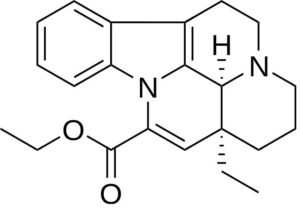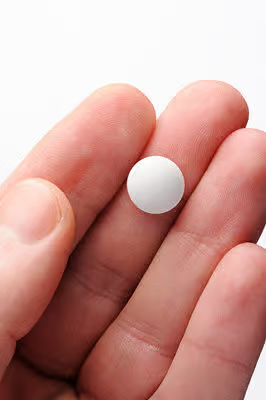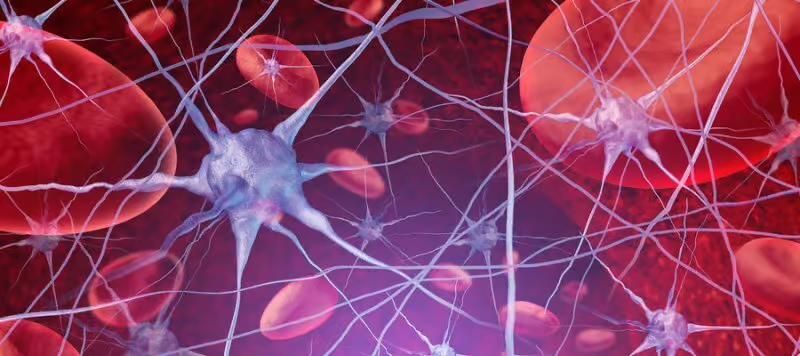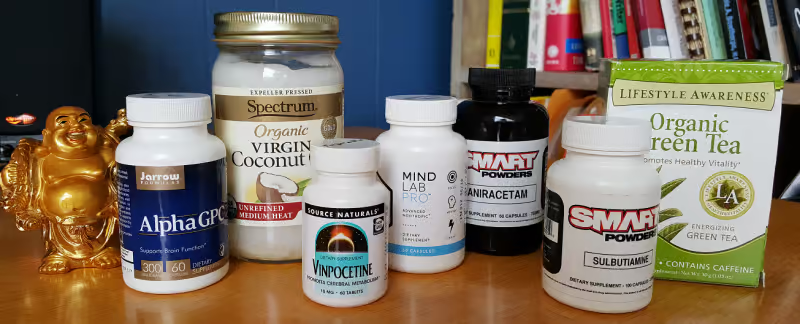Table of Contents
Vinpocetine (periwinkle extract, ethyl apovincaminate, Cavinton, Bravinton, Ceractin, Intelectol) is a semi-synthetic derivative of vincamine, an alkaloid derived from the lesser periwinkle plant (Vinca Minor L.).

Vinpocetine was first isolated from the periwinkle plant in 1975 by chemist Csaba Szántay. Hungarian pharmaceutical company Gedeon Richter began manufacturing Vinpocetine in 1978. Vinpocetine continues to be one of the company’s top selling drugs world-wide.[i]
Vinpocetine is used as a prescription drug in Japan, Europe, Mexico and Russia for the treatment of cognitive and cerebrovascular disorders. In the USA and Canada, Vinpocetine is sold as an OTC dietary supplement.
As a nootropic, Vinpocetine is used primarily to increase cerebral blood flow.
Other uses include using Vinpocetine for the prevention of motion sickness, menopause symptoms, chronic fatigue syndrome, seizure disorders, hearing and eye disorders, and even as a topical application to increase female sexual response.[ii]
Here we’ll investigate Vinpocetine’s value as a nootropic and to optimize cognition.
Vinpocetine helps:
- Cerebral Circulation. Vinpocetine helps boost blood flow to and within the brain. Improving the flow of oxygen and glucose that feed ATP to power brain cells. Improving alertness, cognition, concentration, memory and mood.
- Neuroprotectant. Vinpocetine blocks the accumulation of sodium in neurons, reduces the toxic effects of oxidative stress, inhibits the enzyme PDE1 and boosting blood flow, scavenges free radicals, and protects neurons from glutamate and NMDA toxicity.
- Neuroplasticity. Vinpocetine inhibits the enzyme PDE1 which can increase cAMP and cGMP. These cyclic nucleotides in turn activate a series of kinases that phosphorylate the transcription factors cAMP response element binding protein (CREB) and serum response factor (SRF), leading to the expression of plasticity-related genes.[iii] Boosting neuroplasticity enhances cognition and memory.
Overview
Vinpocetine (Cavinton, Intelectol) is a unique nootropic supplement derived from the lesser periwinkle plant (Vinca Minor).
A flowering plant native to central and southern Europe and Turkey, Vinca Minor is also grown as ground cover in the United States.

Since it was first released in 1978, Vinpocetine has earned a well-deserved reputation with the nootropics community for optimizing cognitive health. Primarily by boosting cerebral blood flow.
But to understand how and why Vinpocetine boosts cognition and protects your brain, we need to dive in to how blood flows in your brain.
An optimized adult brain gets about 1/7th of your heart’s output of blood every minute. Your brain needs this blood flow for a constant supply of glucose, oxygen and other nutrients to keep it functioning properly.
Unlike other organs and muscles in your body, your brain cannot stand an interruption in this steady flow of blood.
Two carotid arteries in the sides of your neck send blood to the front and top of your brain. Arteries in your vertebrae (spine) join with your carotid arteries at the base of your brain to form the Circle of Willis.[iv]
The Circle of Willis is critical because it is the only area of your body where all four major blood vessels join. Allowing blood to be sent to areas where it is needed. Even if one of the major blood vessels becomes blocked.
We’ll take a look at “How things go bad” later in this article. The good news is that Vinpocetine can have a profound effect on maintaining and repairing your brain’s blood vessels, cerebral blood flowing through the Circle of Willis, and to individual brain cells.
Vinpocetine not only helps increase cerebral blood flow, it also works as a powerful antioxidant and anti-inflammatory in your brain.
How does Vinpocetine work in the Brain?
Vinpocetine boosts brain health and function in several ways. But two in particular stand out.
- Vinpocetine boosts cerebral circulation. Your brain only accounts for about 2% of your bodyweight, but it consumes about 20% of the oxygen and nutrients circulating in your blood.[v] This is why strong, healthy cerebral blood flow is so critical to your brain health and cognitive performance.
Vinpocetine inhibits an enzyme called PDE1 (phosphodiesterase type 1) while reducing calcium levels in brain cells. When both of these are elevated, the smooth muscle in blood vessels contract, narrowing the diameter of blood vessels. And restricting blood flow to that area of the brain.
You may be familiar with PDE5 inhibitors like Viagra® which work to dilate blood vessels and maintain healthy blood flow to your penis. Vinpocetine has a similar mechanism of action in your brain.
In two separate clinical studies, chronic ischemic post-stroke patients were treated with either a single infusion, or daily infusion of Vinpocetine for 2 weeks.
Vinpocetine increased cerebral glucose uptake and glucose metabolism in both the stroke region of the patient’s brains as well as the intact brain tissue.
Patients in the 2-week long treatment also showed increased cerebral blood flow especially in the thalamus, basal ganglia and visual cortex regions of the brain.[vi]
- Vinpocetine is an anti-inflammatory. Vinpocetine prevents the upregulation of NFκB (nuclear factor kappa-light-chain-enhancer of activated B cells) by TNFα (tumor necrosis factor alpha).
This sounds a little complicated, but has serious implications in the development of Parkinson’s and Alzheimer’s Disease. Here’s how it works…
NFκB is a protein complex that controls transcription of DNA, cytokine production (signaling protein) and cell survival. TNFα is a signaling protein (cytokine) involved in inflammation produced by neurons. Vinpocetine inhibits this action.
Vinpocetine also reduces the TNFα-induced expression of the mRNA of pro-inflammatory molecules such as interleukin-1β, monocyte chemoattractant protein-1 (MCP-1), and vascular cell adhesion molecule-1 (VCAM-1).
Researchers have found that Vinpocetine prevents this inflammatory response at the cellular nucleus level. And this mechanism of action is independent of Vinpocetine’s action on PDE1.
This is a very big deal because TNFα contributes to the neuronal cell death found in Parkinson’s Disease. And there is growing evidence that the accumulation of amyloid-β protein leads to an upregulation of interleukins and TNFα that contributes to neurodegeneration leading to Alzheimer’s Disease.
Scientists are now working on trying to determine if Vinpocetine can reduce inflammation in the brain. And help protect the brain from developing Parkinson’s or Alzheimer’s.[vii]
How things go bad
Poor cerebral blood flow, inflammation and free radicals (oxidation) can damage your brain. And one of the ways this manifests is memory loss. Left unchecked, it can develop into serious neurodegenerative diseases like Alzheimer’s and Parkinson’s Disease.
↓ Cognitive function declines
↓ Inflammation kills brain cells from the inside
↓ Free radicals destroy neurons and synapses
↑ Anxiety, depression and moodiness increase
↓ Concentration and memory declines
Poor cerebral circulation causes a domino effect in the brain affecting many critical processes. Memory, cognition, and decision-making all suffer as a result.
Vinpocetine benefits
Vinpocetine is one of the most researched nootropics on the planet. It was introduced to clinical practice in Hungary in 1978 for the treatment of cerebrovascular (brain blood flow) disorders and related symptoms.
Since then Vinpocetine has become a “reference compound” in pharmacological research of cognitive deficits caused by hypoxia (oxygen deficiency), ischemia (inadequate blood supply) and research into cyclic nucleotides (cAMP and cGMP).
Vinpocetine’s mechanism of action in the brain includes:
- Increasing brain blood circulation and oxygen utilization
- Increased tolerance for hypoxia and ischemia
- Anticonvulsant activity
- Inhibiting the PDE1 enzyme
- Increasing the pliability of red blood cells
- Inhibiting the aggregation of platelets (blood clots)[viii]
Hundreds of studies in animals and humans have shown Vinpocetine can repair and reverse the effects of damage caused by strokes. Vinpocetine can prevent the inflammation and damage by free radicals that can lead to neurodegenerative diseases like Parkinson’s and Alzheimer’s.
Vinpocetine can improve glucose and oxygen supply to critical brain cells through increased blood flow. Improving cognition, concentration, mental agility, anxiety, depression and memory.
How does Vinpocetine feel?
You should be able to feel the effects of Vinpocetine within an hour of taking it.
Neurohackers report that Vinpocetine reduces brain fog and mental fatigue. Most experience improved focus, memory and even an improved sense of well-being.
Vinpocetine’s effect on short-, working- and long-term memory can be profound. Remembering names, numbers and life events becomes easier.
At work or in school, Vinpocetine can assist in learning and helping your brain commit it to memory. You should feel a significant difference in your ability to focus at work.
And like any nootropic, Vinpocetine is not going to turn back the clock 30 or 40 years. But it will help to keep your brain functioning more smoothly.
Vinpocetine Clinical Research
Vinpocetine Improves Memory
12 healthy female volunteers were treated with 40 mg Vinpocetine 3-times per day, or a placebo, for 2 days in this randomized double-blind crossover study.
On day 3 of the study, and one hour following morning dosage of Vinpocetine, the women completed a battery of psychological tests. The study found that those who used Vinpocetine had a significant improvement in memory when compared to placebo.[ix]
Vinpocetine Repairs Long-Term Potentiation
If you have been having problems with long-term memory lately, this study is for you.
Researchers produced a “medial septal lesion” on rats in the lab. The medial nuclei are an area of the brain composed of medium-size neurons. These neurons receive signals from different areas of your brain including your hippocampus.
A lesion cuts off communication with an important memory-formation area of your brain. The effect of a lesion in this study was on hippocampus function and the long-term potentiation pathway.
The scientists found that damage in this area of the brain negatively affects long-term potentiation. The rats were then given either physostigmine, piracetam, Vinpocetine or Hydergine one hour after the lesion. And once-a-day for 6 days after the operation.
The study found that all of the drugs used in this study produced complete restoration of long-term potentiation. And shows that Vinpocetine is one of the most effective and least expensive ways to restore long-term potentiation and long-term memory formation.[x]
Vinpocetine Enhances Cognitive Performance
A placebo-controlled, randomized double-blind trial was conducted at the University of Surrey with 203 dementia patients using Vinpocetine. Patients received either 10 mg of Vinpocetine 3-times per day, 20 mg of Vinpocetine 3-times per day or a placebo 3-times per day for 16 weeks.
The patients were assessed on cognitive performance and measure of quality of life, including depression. Both Vinpocetine groups experienced a significantly improved cognitive performance score compared to placebo.
The study concluded that Vinpocetine was useful in the management of patients with symptoms of dementia. And there was no statistical difference in cognitive scores with 10 mg or 20 mg of Vinpocetine.[xi]
Vinpocetine Dosage
Vinpocetine has a reputation among neurohackers and in clinical trials for safety at recommended doses.
The recommended dosage for Vinpocetine is 10 mg taken 3-times per day with food. Vinpocetine seems to be more effective when taken with a meal or high quality fat like coconut or olive oil.
You can safely dose up to 60 mg of Vinpocetine per day total. But clinical trials and user experience nearly always report that higher doses provide no added benefit.
Vinpocetine Side Effects
Vinpocetine is well-tolerated and safe for use by most people. But if you’re particularly sensitive to supplements and drugs, try a starting dose of 5 mg of Vinpocetine and see how your body reacts.
If you’re dealing with low blood pressure you should avoid using Vinpocetine. This nootropic affects blood flow not only in your brain, but through your entire system. If you take Vinpocetine and feel light-headed or dizzy it could be a sign your blood pressure is low.
Vinpocetine affects clotting factors in your blood. And may decrease red blood cell platelet aggregation. So if you are using blood thinners or high doses of aspirin you should avoid Vinpocetine.
Stop taking Vinpocetine at least 2 weeks before surgery because of its effect on blood thinning and flow.
The US FDA issued a warning June 2019 stating that women who are pregnant or intend on becoming pregnant should not use Vinpocetine. Because a recent animal study shows that Vinpocetine decreased fetal weight and increased the chances of a miscarriage.
Where to buy Vinpocetine
Vinpocetine usually comes in 5, 10 or 20 mg tablets.
Many countries around the world require a prescription to purchase Vinpocetine. In the USA, the FDA recently added Vinpocetine to its “Dietary Supplement Ingredient Advisory List“.
The FDA says this list, “is intended to quickly alert the public when the FDA identifies ingredients that do not appear to be lawfully included in products marketed as dietary supplements.”
In this instance, Vinpocetine was put on FDA’s list at the request of a major pharmaceutical company who intend to make and market it as a prescription drug. Which means you can no longer buy Vinpocetine from vendors such as Amazon or Bulk Supplements.
I use and recommend: Life Extension – Vinpocetine
Nootropics Expert Recommendation
Vinpocetine 10 mg 3-times per day
 We recommend using Vinpocetine as a nootropic supplement.
We recommend using Vinpocetine as a nootropic supplement.
Your body does not make Vinpocetine on its own. So you must take it as a supplement.
Vinpocetine easily crosses the blood-brain barrier and is available within an hour of taking it. Vinpocetine works more effectively if taken with food.
Vinpocetine is especially helpful for those suffering from brain fog and memory loss. Vinpocetine helps increase cerebral blood flow bringing more oxygen and nutrients to brain cells.
Vinpocetine is helpful for those dealing with stroke recovery. This nootropic helps restore blood flow to damaged areas of the brain affected by stroke. And helps prevent damage caused by the increase in free radicals typically released during stroke recovery.
Vinpocetine is also helpful for those suffering from Alzheimer’s. It has been shown to boost blood flow to areas of the brain affected by amyloid-β protein aggregation. Vinpocetine helps tame inflammation associated with the disease. And studies are now underway to determine if Vinpocetine can prevent Alzheimer’s from taking hold in the first place.
You can safely take up to 60 mg of Vinpocetine daily if needed. One dose first thing in the morning. One dose early afternoon. And the last dose in the evening.
And for memory, Vinpocetine is great to stack with most of the racetams. Neurohackers report good success stacking Vinpocetine with Gotu Kola.
I use and recommend: Life Extension – Vinpocetine









Join The Discussion - 165 comments
Cip
January 12, 2022
I see some studies that conclude that it can be used for pain relief: https://www.hindawi.com/journals/mi/2019/6481812/
Do you have any knowledge about this?
I am searching for ways to reduce chronic pain (non-specific lower back pain, tingles etc.).
Thanks!
David Tomen
January 12, 2022
Cip, I cover this under the section called “How does Vinpocetine work in the Brain?” and how Vinpocetine reduces inflammation. I do not spend a lot of time talking about this benefit because it is not the primary reason people use Vinpocetine. So, Vinpocetine would not be my first choice when it comes to pain reduction.
The best nootropic for dealing with pain by far is Kratom. Others such as Turmeric, Pine Bark Extract, CBD Oil and Black Seed Oil are better choices for reducing inflammation in my opinion than Vinpocetine.
Robert
November 30, 2021
Hi ! Which vendor are you using currently ? TY
David Tomen
November 30, 2021
Robert, if you are referring to where I get my Vinpocetine, I get it from Life Extension.
Marketa Kropacova
November 16, 2021
Vinpocetine really has so many wonderful uses and has been widely used for decades as you mention. Thanks for sharing your excellent insights on the topic David, your post is a very good read.
David Tomen
November 18, 2021
Thank you Marketa.
Domenico
November 22, 2021
Hello David, trust your are well. Quick question? I just got Vinpocetine and already took 20mg, then you came timid and had q look at Vinpocetine interactions. I am taking Nattokinase, Lumbrokinase and Serrapeptase and Vitamin K2 mk4,mk7 amongst other things, as I do have a blockage in the LDA but I am asymptomatic. Generally I feel great do not have high blood pressure nor abnormal palpitation heart feel good, I am insuline resistant slightly. DO NOT TAKE STATIN NOR ASPIRING. Q:? is it fine to take Vinpocetine ??? Thank you from down under…NB. I do have your books and learning a lot… keep doing what you do………….Ciao Domenico Stallo
David Tomen
November 29, 2021
Domenico, Vinpocetine is one of my favorite nootropics and the best way I know of to boost blood flow in your brain.
BTW, Berberine is a great way to treat insulin resistance.
Chris Drennen
August 31, 2021
Are vinpocetine and pine bark redundant? Which one do you like better? Do either one interact negatively with any other other nootropics thatyou know?
David Tomen
September 1, 2021
Chris, for better brain blood flow I think Vinpocetine is better with Pine Bark Extract a close “runner up”.
Each one provide other important benefits so it is not “redundant” to use both. Check the Side Effects section of each review to see if it is contraindicated with anything.
Marcie webber
August 27, 2021
Does Vinpocetine also works in other parts of the body aside from the brain circulation? i noticed T get subtle tingling in my feet shortly after a dose. I take it with Ginkgo together but Ginkgo doesn’t show effects fast as stated.
Thank you.
David Tomen
August 28, 2021
Marcie, while we use Vinpocetine primarily to increase cerebral blood flow it will affect the rest of your body too. All the benefits seen above under the Vinpocetine Benefits section and “How does Vinpocetine work in your brain?” carry over to the rest of your body.
Ed
August 26, 2021
Hi David,
Do you know whether or not Vinpocetine has any advantage over Ginkgo Biloba, visa versa, or if one is just an equal redundancy of the other?
Vinpocetine seems to have a slightly higher risk factor – I’ve read one off adverse reports of things like the following below. And so if there is no reason to take Vinpocetine if I am already taking Ginkgo, then it seems prudent to only take the safer option (even though Vinpocetine doesn’t have enough adverse events to be considered ‘risky’). But I have no idea -Would you mind filling me in? 🙂
fixed drug eruption (when taking Vinpocetine and Ginkgo together):
https://pubmed.ncbi.nlm.nih.gov/29344321/
Agranulocytosis and Pregnancy Issues:
https://www.mskcc.org/cancer-care/integrative-medicine/herbs/vinpocetine
Potential Contraindications with other P-glycoprotein substrate nootropics: “In vitro studies indicate that vinpocetine strongly inhibits P-gp and may therefore alter the pharmacokinetics of substrate drugs (32). Clinical relevance has yet to be determined.” (David, I’m not sure what nootropics for which this finding would raise a flag – would you happen to know?)
(P.S.: David, I apologize if this question has been asked of you before. It would be really great if you could include a ‘key word’ search feature in your comments section – whereafter entering the key word brings up all comments/chains that include that key word)
David Tomen
August 27, 2021
Ed, Vinpocetine and Ginkgo Biloba each have very different mechanisms of action in your brain. But both are know for increasing cerebral blood flow. Vinpocetine more so than Gingko.
P-glycoprotein is a protein of the cell membrane that pumps foreign substances out of cells. It is not a natural feature of a specific nootropic but of the cell membrane itself.
Also note that the first study you pointed to says, “Cutaneous adverse effects from Ginkgo biloba and vinpocetine are infrequent.” That study was a case report of a one guy who had an adverse reaction to using both supplements. The underside of his penis right before the glands turned red. I’ve been doing this for many years and that one is new to me.
See my individual reviews for each and specifically the “Side Effects” section for each nootropic. Neither supplement is “risky” as long as anything in the Side Effects section applies to you.
I personally prefer Vinpocetine for increasing brain blood flow.
There are several features I’d like to use in the comments section for each of these nootropic supplements. But my IT guy and I have tried several different options and each one presented a problem which prevented us from using it. So we are stuck with this antiquated comment system until I find something better and that works without messing something else up.
Toni
June 15, 2021
Hi David, Thank you for all your info. I suffered sudden hearing loss in January with severe tinnitus and have been taking Vinpocetine 30mg a day (which I believe has been helping). I am due for a follow up MRI and was wondering if I should stop taking Vinpocetine a couple of weeks prior? i.e. will the benefits of the Vinpocetine mask what’s going on with my brain? I should note that it is not allowed in my country so I can’t tell the neurologist I’m taking it. Many Thanks
David Tomen
June 16, 2021
Toni, good question and I do not know if Vinpocetine will mess with the results of your MRI. I don’t think anyone has an answer to that. But if it is worrying you then stop using Vinpocetine a couple of days before the MRI.
Ahmed
April 19, 2021
Hi David
I wonder what I should do if I can’t find Vinpocetine, but can only find Vincamine.
Should I take it?
is it stronger/weaker? should the dosage be adjusted?
Also what is your opinion on combining it with Piracetam?
Since I found an OTC drug in pharmacies called “Cervitam”
Which has 400mg of Piracetam + 20mg of Vincamine
How often do you think I should take it.
P.S if age is relevant, I am 19
David Tomen
April 20, 2021
Ahmed, Vinpocetine is a derivative of vincamine. The latter is sold in Europe as a drug to treat and prevent blood flow disorder in the human brain. Just like Vinpocetine.
I haven’t tried vincamine so can’t say if it is as effective as Vinpocetine. But it is certainly worth trying if you cannot get Vinpocetine.
The maximum safe dosage of vincamine is 20 mg per day and we only have data for use up to 6 months. There is nothing indicating that it is safe beyond daily dosing for longer than 6 months. But that is like most dietary supplements anyway.
I’m not sure why it would be added to Piracetam because the latter requires a choline supplement to get the full benefit of Piracetam. Vincamine is not a choline supplement.
Ahmed
April 21, 2021
Thanks for the reply David!
Follow up question. Is it okay to take Vincamine with Ginkgo Biloba?
or will that increase cerebral circulation “too much” (if that’s a thing)?
Also will it affect blood pressure?
Much appreciated.
David Tomen
April 22, 2021
Ahmed, as long as you are following dosage recommendations I don’t think you have anything to worry about. But blood pressure is another thing and the only way to find out is to try them and find out what happens if you take them together.